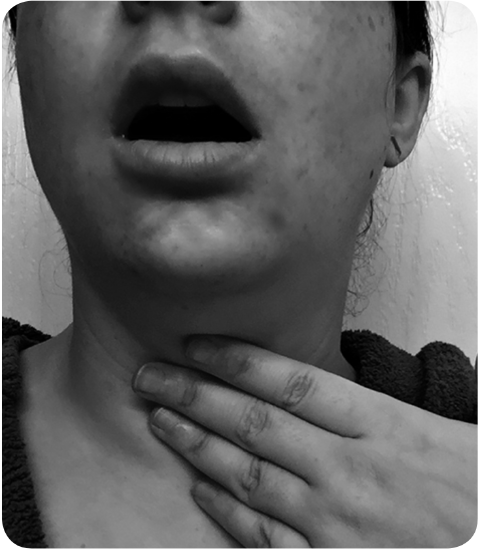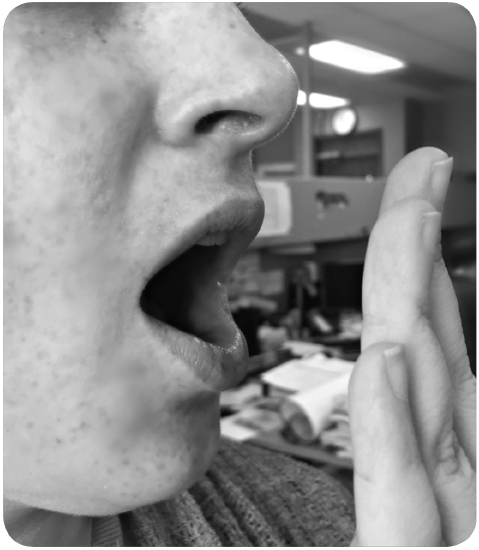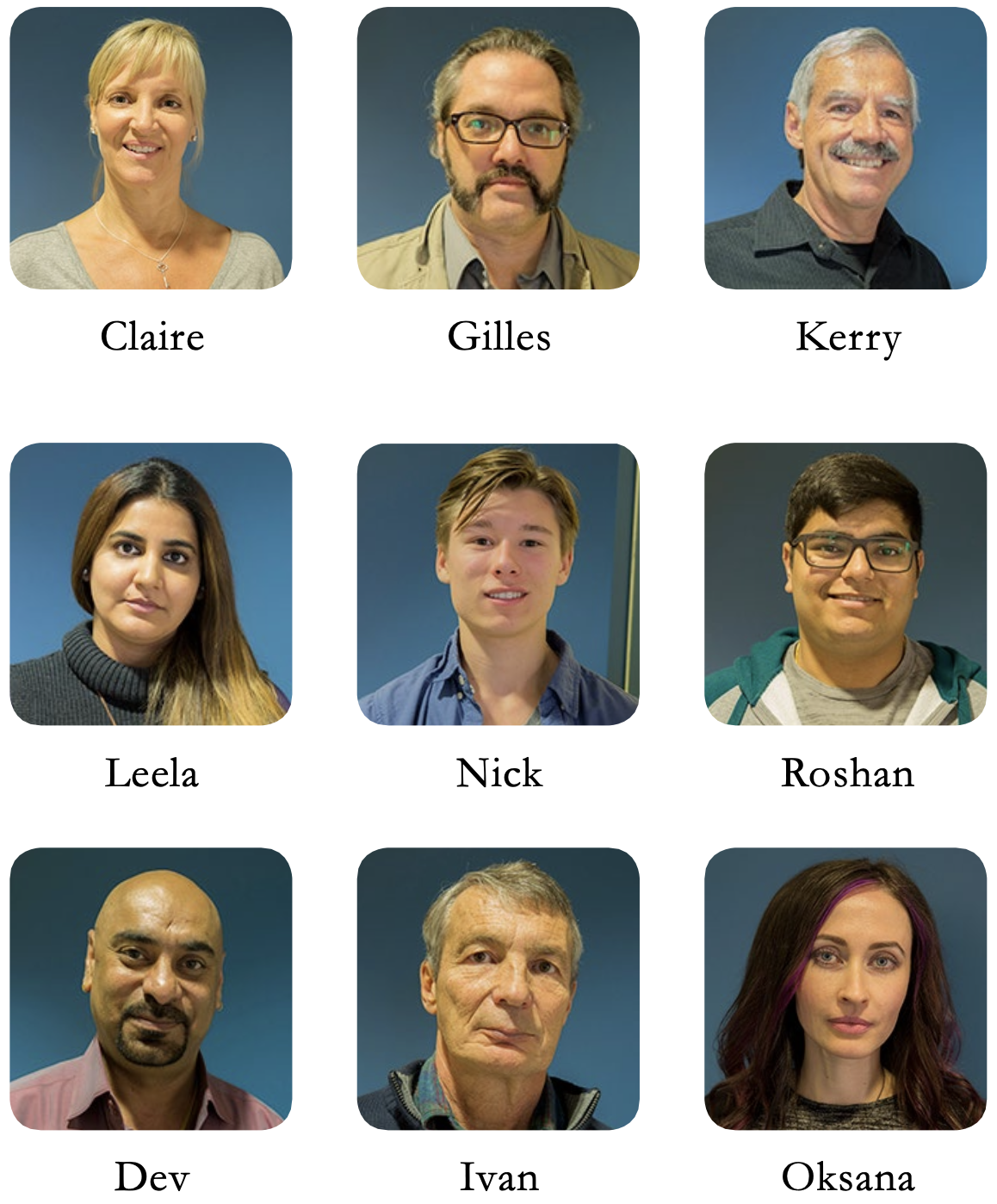5.5: Speaking
- Page ID
- 93499
Intonation Scaffolding Activities
Same Spelling, Different Sounds 
➔ Read this summary of the characters’ actions in this chapter’s video.
Like many stories or reports, this one is about past events. Almost all of the verbs are in the past tense.
➔ Identify all the verb forms, simple past or past participles, spelled with an -ed suffix. (For a review of verb forms refer to Chapter 4, page 202.)
 Listen to this summary. As you listen, read out loud, shadowing the voice on the audio track.
Listen to this summary. As you listen, read out loud, shadowing the voice on the audio track.
The scene started in Claire’s office at Bear Bottom Campground. Roshan noticed that Claire’s laptop was open. He looked at the screen. When he said, “Whoa,” he sounded surprised. Gilles walked to the desk. He leaned over and his eyes widened. The guys talked about the website. Gilles admitted that his students had told him about this site where people rated other people’s appearance. Gilles recommended closing the laptop. Roshan clicked on choices and voted. The guys wondered why Claire had opened the site. Roshan didn’t think Claire had posted her own picture. Gilles recommended closing the laptop.
Just then, Claire entered the office. She opens the computer. She asked Gilles and Roshan if they had seen what was on the screen. Gilles paused. Roshan hesitated. Claire pointed at the picture and announced, “This is my daughter.” Roshan almost showed his true thoughts. Claire expressed her concerns. She was worried about her daughter. Gilles reassured Claire, but he barely filtered his own thoughts.
Claire changed the subject. She compared her daughter’s behaviour to Roshan’s. She voiced her unfiltered feelings. She suggested that Roshan should meet Arti. Gilles helped Roshan out by making excuses about his work. Roshan tried to distance himself from Claire’s suggestion. He felt too awkward to speak. Claire, however, didn’t notice that she had crossed a social boundary.
➔ Notice three different pronunciation patterns for the -ed suffix.
Pattern 1

Many regular base verbs end in a voiced sound. A voiced sound is made with movement or vibration by your vocal chords. You should feel this vibration on correctly pronounced vowel sounds, such as the last sounds in TRY or SHOW. You should also feel it on some consonant sounds, such as the last sounds in SURPRISE, LEAN, or WONDER.
To master this -ed pronunciation, you don’t need a teacher or a dictionary. Lay the palm of your hand against your throat. If the final sound in a regular base verb is voiced, the -ed suffix should sound like /d/. This /d/ sound is also voiced. We see -ed but do not pronounce the letter “e.”
Pattern 2
 Many other regular base verbs end in a voiceless sound. A voiceless sound is made with NO movement or vibration by your vocal chords. Instead, you should feel air flow out of your open lips on some consonant sounds, such as the last sounds in NOTICE, LOOK, or SNAP.
Many other regular base verbs end in a voiceless sound. A voiceless sound is made with NO movement or vibration by your vocal chords. Instead, you should feel air flow out of your open lips on some consonant sounds, such as the last sounds in NOTICE, LOOK, or SNAP.
To master this -ed pronunciation, place the palm of your hand in front of your mouth. If the final sound in a regular base verb is voiceless, the -ed suffix should sound like /t/. This /t/ sound is also voiceless. We see -ed but do not pronounce the letter “e.”
Pattern 3
Only two consonants do not fit into Pattern 1 or 2. When the spelling of a base verb ends in “d” or “t,” the -ed suffix that we add to make the simple past form must be completely pronounced as a separate syllable /Id/.
- For example, the verb START ends in a voiceless /t/ sound. When we add the -ed suffix to form the past tense, we can’t communicate the past by saying /startt/. Our listeners need to hear /start-Id/ to understand that the action happened in the past.
- The verb SOUND ends in a voiced /d/ sound. When we add the -ed suffix to form the past tense, we can’t communicate the past by saying /soundd/. Our listeners need to hear /sound-Id/ to understand that the action happened in the past.
To master this -ed pronunciation, recognize a final “d” or final “t” in the spelling of a base verb. Pronounce the -ed suffix as a separate syllable /Id/.
Practise Pronouncing -ed 
Listen again to the audio track of the video summary. Categorize each past tense verb by its -ed pronunciation. The first and second verbs from each pattern are done as examples.
|
Pattern 1 |
Pattern 2 |
Pattern 3 |
|---|---|---|
|
Voiced -ed sounds /d/ |
Voiceless -ed sounds /t/ |
Final “d” or “t” |
|
suprised leaned |
noticed looked |
started sounded |
Check your list by listening to the complete list for each pattern. As you listen, repeat each verb after the speaker.
Speaking Tasks
When the characters in this textbook speak with familiar people, they seem to be quite comfortable sharing their true, unfiltered thoughts. Within their intimate or personal circles, several of them express opinions and rate products or performances more directly and openly than they do in public conversations. In contrast, a few characters don’t filter or withhold much information at any time.
In this chapter, many characters rate, or review, how well or how poorly someone else did something. We heard conversations between Gilles, Ivan, and Roshan as they reviewed the performances of musical groups. They rated the performers on
- appearance, including clothing
- clarity, including how clear their words and voices were
- familiarity, including whether or not the audience connected with the ideas they were communicating
- talent, including how original they were.
The characters pictured below were unfamiliar to you when you began this series of five chapters. Now you may feel that you know them fairly well. You have seen and heard them; you recognize some of their strengths and weaknesses.

To prepare for the next speaking activity, discuss these questions:
- Which of these characters would you prefer to meet?
- Why would you like to meet this character?
- If you could interview an actor playing one of the characters pictured above, what would you ask her or him?
Speaking 1: Expressing an Opinion
Public performers expect to be reviewed. Actors are rated on the roles, or the characters, they play. They appreciate fair reviews that show the reviewer noticed many details about a performance. Performers value reviewers who recognize talent. They also welcome reviewers who thoughtfully identify things they could improve in their performances. Reviewers may see patterns that performers are too busy to pay attention to. Reviewers definitely adjust what words they choose and filter their comments depending on who will hear or read the review.
For this activity, you are a film critic. You will review one character from this textbook. Choose the character that you have the strongest opinion about. Your opinion may be either positive or negative. Which character would you most like or most dislike to meet? Why?
Requirements:
- Introducethepurposeofyourtalk.Identifyyourchosencharacter by name.
- Describehowthischaracterbehaved.Useatleastfiveregularpast tense verbs.
- Describe the attitude(s) this character showed toward others. Use at least three of the five intensifying adverbs practised earlier in this chapter.
- Express whether or not you would like to meet this character. Give at least two reasons.
To prepare for this task:
- Research the character of your choice by watching the five chapter videos again.
- Listen to some of the audio tracks for the listening activities.
- Keep in mind that the character will never hear your review.
Production Task Rubric 
Use the rubric on the right to measure how effectively you reviewed a character.
|
Speaking Task 1 You expressed an opinion about a public performance and described related behaviour. |
Completely |
Mostly |
Somewhat |
Comments |
|---|---|---|---|---|
|
You introduced the character you chose to review. |
||||
|
You described the character’s past behaviour. |
||||
|
You used correct -ed suffix pronunciation. |
||||
|
You described the character’s attitude with intensifiers. |
||||
|
You expressed your opinion of this character. |
Speaking 2
Public performers expect reviewers to watch all the actors in a performance. A review often includes comparisons or contrasts between a couple of actors. The reviewer considers the following questions:
- How believable were the actors?
Were they realistically playing their roles? Were those characters true to life? - How talented were the actors?
Did they communicate well by voice and action? Was their speech clear and understandable? Were their facial expressions, gestures, and other body language natural? - How appealing were the actors?
Did you, and would other people, enjoy watching them?
For this activity, you are the reviewer. You will express your opinion by rating the performances of two actors. Choose any two of the actors in the chapter videos that you are familiar with.
Requirements:
- Introducethepurposeofyourtalk.Identifyyourchosenactorsby their “stage” names.
- Rate how believable they were. Use regular past tense verbs to describe at least three realistic or unrealistic actions by each actor.
- Describe how talented they were. Use at least three regular past tense verbs to describe how they communicated with words and body language.
- Expressyouropinionofhowappealingtheywere.Useallfiveof this chapter’s intensifying adverbs.
To prepare for this task:
- Watch the five chapter videos again.
- Keep in mind that the actors or their director may hear your review.
Production Task Rubric 
Use the rubric on the right to measure how you do when reviewing an actor’s performance.
|
Speaking Task 2 You described two public performers and expressed your opinion. |
Completely |
Mostly |
Somewhat |
Comments |
|---|---|---|---|---|
|
You introduced the actors you chose to review and the characters they played. |
||||
|
You described realistic or unrealistic actions. |
||||
|
You described their speech and gestures. |
||||
|
You used correct -ed suffix pronunciation. |
||||
|
You rated which actor was more appealing. |
||||
|
You clarified your rating using intensifying adverbs: very, really, so, such a, and too. |

